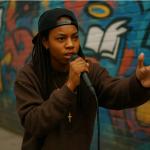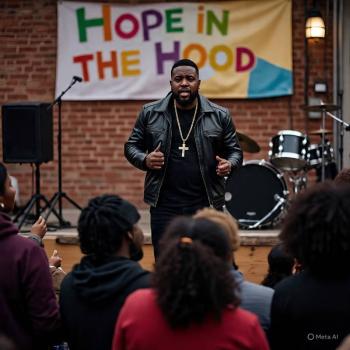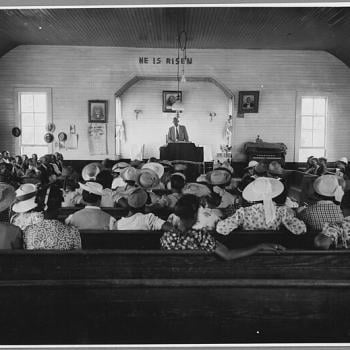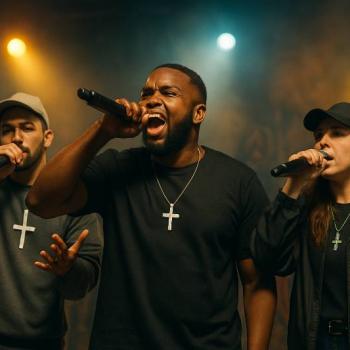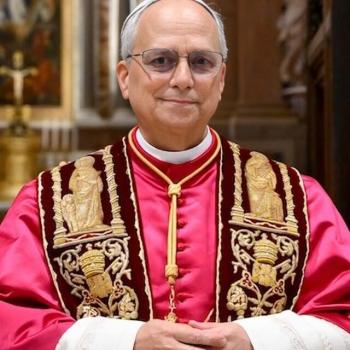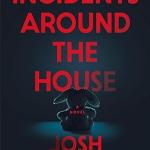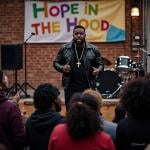When you devote yourself to a discourse, the entire discourse needs to be addressed. My area of interest, pedagogy and writing, is in Hip Hop, with an emphasis on Christian Hip Hop. I have, and remain, intrigued by the power that breakdancing expels. For the viewer, this artistic expression defies gravity and physical limits. As the performer, this style is the method through which the average man can be reached, first visually, then in conversation. To critically read how breakdancing serves to heighten the discipline of Christian Hip Hop culture is a fascinating, physically stunning read.
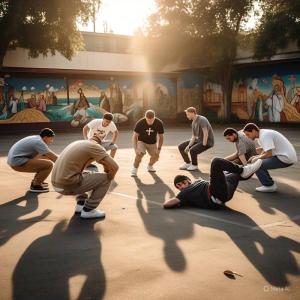
“Tricia Rose’s foundational text Black Noise (1994) positions U.S. hip-hop as a counter-narrative to racial capitalism and structural exclusion. She analyzes how hip-hop aesthetics, such as sampling, remixing, and layering, mirror Black cultural resilience. Jeff Chang’s Can’t Stop Won’t Stop (2005) offers a comprehensive history of the hip-hop generation, situating the genre within broader movements of youth-led resistance and social transformation. Chang frames hip-hop not just as music, but as a cultural revolution born of necessity” (Landazuri, 2025).
Bustin’ Through History
Breakdance has a long history through the fabric of the African diaspora. Movement through Jamaica and the Caribbean brought diversity to dance styles. Used as a means of expression, cultural exchange, and storytelling, dance in the African diaspora was exploited by salve owners in the American South as a means of entertainment. The restriction of dance to a specific day (Sunday) or on holidays, slave owners would grant permission for African slaves to dance, sing, and participate in what the slave owners recognized as entertainment. The subtextual use of these expressions allowed for cultures to be shared and appropriated for survival and the development of new methods of identity. The lack of drums demanded that the body become the sounding agent. Slapping, stomping, and rhythmic pulsations replicated the pulse of the drum central to African expressive culture. Embracing religious and ritualized dance styles, dance was framed more than a means to celebrate culture, but as a way to practice, through physical coding, religion. It was the appropriation and mix of these cross-cultural styles that gave birth to the American dance culture.
Compartmentalized in the urban centers, the complex history of these dance styles further acculturated modern dance styles, martial arts, and other religious dance elements. The body continued to be a location of rhymic expression, even when music was provided by DJs.
DJ Kool Herc made a huge contribution to the overall development and progress of Hip Hop culture. He is the one who coined the term “B-boys,” which is short for “break boys” about the break in the records DJs would use and play repetitively to give dancers time to showcase rhythmic moves, acrobatic styles, and controlled body motions.
Breakdancing began in the South Bronx, New York City, in the early 1970s. Neighborhoods were defined by cultural diversity and resilience in the face of significant economic struggles. At this time, neighborhoods were heavily impacted by urban decline, cuts to public services, and the rise of crime and drug abuse. Limited economic opportunities and declining community support systems led youth to turn to the streets for cultural and personal survival. The growing need for a space to create and define culture, African American, Latino, and other included communities, began to include the cultural context of dance. Following the dance traditions of the African diaspora and Capoeira, breakdancing evolved as a means of personal expression, friendly competition, and storytelling. The physicality of the body, through control and active engagement, was juxtaposed to the rhythms and sounds of the DJ, the city, drawing on the rich dance traditions of their home culture (Alles, 2024).
“DJ culture and block parties helped promote the evolution of breakdancing. The instrumental breaks provided by the DJs gave space for the creative interaction of martial arts (Capoeira) and gymnastics, with a combination of footwork and choreographed dance routines (Steppin’ by way of the African diaspora dance culture)” (Ramos, 2025).
Breakdance is one of the foundational elements of Hip Hop culture. The socio-political history of this art form is lost to most. There are remnants of the socio-religious elements still present in style, use, and presentation. Focusing on the socio-religious elements of early breakdance, this visual and visceral art form is ripe for the activation of discipleship. Community involvement is necessary for breakdance. Enveloping this association with a scripture-centered discourse, Christian breakdance is an agent for Christian Hip Hop culture: testimonial, discipleship, scripture-centered doctrine, and a biblically-centered lexicon. Breakdance immediately incorporates each of these elements in a physical domain. The location of biblical culture is recognized in the body.
A good example of each of the core techniques in breakdance is the Dance Battle Competition (2022). Titled “When Dancers Go God Mode,” don’t let the title lead you adrift. There are no Christian breakdancers in this example. I incorporate this to demonstrate the complexity of styles to build on this to read how Christian breakdancers incorporate different techniques to execute a biblically-centered doctrine through dance.
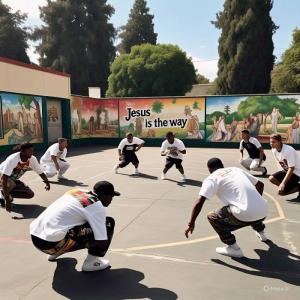
Breakdance Ministry
Author Bonnie Eissner (2021) contextualizes the progression of Hip Hop culture through “urban decay.” At this epicenter, Hip Hop took active control of cultural expression, despite the urban decay, to frame a means of expression. Christian breakdance provides a similar response, but to a decay in sharing the gospel with youth, a “spiritual decay” or a “discipleship decay.” The use of a highly dynamic and visually stunning art form, breakdance, has the potential to open dialogue for sharing scripture with youth.
The large number of Christian breakdancers is more aligned with the steppin’ style, incorporating the body as an instrument to create rhythm and sound through choreographed dance steps. Historic and traditional breakdance techniques like the slide, poppin’, breakin’, and the spin, just to name a few, are not present. There are very few examples of these techniques in the Christian breakdance arena.
Breakdance For Discipleship
The Christian Heart has a fully dedicated Christian Breakdance Ministry. The unnamed leader of this ministry codifies the argument for discipleship in Christian breakdance.
“My ministry is not what you would normally expect. From the outside, you will see a group of young guys from all different backgrounds breakdancing and having a blast. What is actually happening is discipleship.”
Going one step further, the Christian Breakdance Ministry confirms the importance of community for the dance style and building a biblically-centered culture.
“Breakdancing is a great tool for this community because it is in every major city center around the world. It is mainly comprised of men, ages 18-35, which has been a hard group for the church to reach. We get to engage at the deepest levels of life with these men.”
To further articulate the involvement and active sharing of the gospel, this breakdance ministry provides the following,
“We are not a performing group but a missional organization, reaching a specific culture that is often unreached so that lives are transformed by the Gospel of Jesus Christ.”
What stands out is the acknowledgment that this ensemble is not a “performing group.” Rather, the ensemble qualifies itself as a ministry that happens to use breakdance to reach a demographic otherwise difficult to connect. Each of these points solidifies how Christian breakdance is a core element in the overarching Christian Hip Hop culture.
Breakdance As Worship
The group Swagg Boyz, is a prime example of a steppin’ ensemble. Performing at the Christian Hip Hop Showcase, their polished style of choreography and body sound demonstrates the steppin’ style.
Righteous Dance is another example of a steppin’ style. The community involvement and ease that the steppin’ style provides lend themselves to articulating discipleship. The individualized style of traditional breakdance is neutralized to afford community involvement. In addition, steppin’ does not involve the highly athletic techniques so often associated with traditional breakdance.
Blessings on Blessings (B.O.B. Bounce) ties all these elements together. Showcasing poise and style in a smooth, choreographed style, this example highlights the community element central to Christian breakdance. It is this element, community involvement, which speaks across the definitions of Christian Hip Hop culture. The dance segments start 40 seconds into the video, but remain central throughout. This video also provides the interjection of dance in different areas of daily life. Remaining dedicated to the steppin’ style, yet absent of the body-sounding rhythms, B.O.B. Bounce levels the steppin’ tradition to a more common discipline available for all to participate. This speaks to the necessity of scripture and discipleship in daily life to “dance” biblically-sound and construct a personal testimonial to be shared, physically, to those with whom you interact, or rather, dance.
Bizzle’s, “No Hate,” incorporated traditional breakdance styles. Throughout the video, breakdance is situated in a solo style. It’s only at 3:08 into the video where the community is represented. The use of the single perspective may read as a counterpoint to the elements of Christian Hip Hop and how breakdance is used to articulate these elements. What Bizzle provides is an inverse reading and application of dance to support the Christian Hip Hop discipline. Where the solo dancer is the prominent image of dance, the community involvement is presented in the lyrics of the work. This releases the dancer from having to communicate on a collective level, thus contextualizing the dancer as a testimonial and street preacher identity. Nearly all the placements of the solo breakdancer are in a street environment. This gives relevance to the solo dancer as a preacher, sharing a testimonial. The involvement of scripture-centered lyrics and a biblically sound discipline is bound together through the cooperation of the rap, the music, and the solo dancers. Interesting to point out that Hip Hop culture is founded on a strong drum beat, albeit acoustic or electronic, this work does not rely on a drum. Rhythmic hand clasps replace the undulating pulsation of the drum. This qualifies the community involvement further, while also undercoring the body rhythmic sound noted in the steppin’ style, and gives the solo dancer a collective platform to engage. Once community representation is introduced in the video, the community is visually presented further. This can be critically read as a transformation from an individual relying on their understanding of the gospel to being reliant on the Lord and community to support their walk, or dance, with/for the Lord. “No Hate” is a complex work when read through a breakdance lens.
Move For God (M4G) is an example that appropriates Bizzle’s track “No Hate” and narrates it through a steppin’ style. This ensemble returns to the community involvement of Christian breakdance. The choreographed steppin’ style is the backbone of this work, speaking to the composite community involvement and support. A reading of how discipleship is witnessed is apparent. What this track does, as the other steppin’ examples work to communicate as well, is the singular testimonial couched in the fabric of the community. The singular voice is not as important as supporting and serving the community. In physicality, this is how scripture is articulated, and he building of a biblically-centered doctrine. The scripture noted is Matthew 20:28.
[J]ust as the Son of Man did not come to be served, but to serve, and to give his life as a ransom for many (NIV).
It is this scripture that is being presented through Christian breakdance. Even in the steppin’ style, the perspective of serving others, not to be served, is key.
B-boy/C-boy
The use of breakdance to broadcast scripture and build discipleship is an agent overlooked. In the composite of Hip Hop culture, this practice is easy to overlook. However, the immediacy that breakdance provides to narrate scripture and function on a biblically sound doctrine, without having to open the mouth, is incredible to witness. To know that as you are learning to spin, slip, helicopter, or freeze, you’re also sharing the gospel elevates this expressive discipline to another level.
For where two or three are gathered in my name, there am I among them (Matthew 18:20 ESV).


